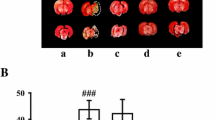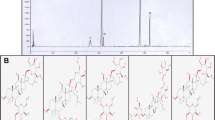Abstract
Objective
To investigate whether combination treatment with Taohong Siwu Decoction (桃红四物汤, TSD) and recombinant tissue-type plasminogen activator (rt-PA) potentiate in reducing infarct volume and alleviate thromboembolic stroke in an in vivo rat model.
Method
Adult male Wistar rats were subjected to embolic middle cerebral artery occlusion (MCAO) and treated with rt-PA (4 and 8 mg/kg) alone (n=5), TSD [0.7 g/(kg·day)] alone (n=5), combination of rt-PA and TSD, 24 h after stroke. Rats were sacrificed at 14 days after treatment and lesion volumes were measured. To investigate the underlying mechanism of neuroprotective effect of the combination treatment, cleaved caspase-3, tumor necrosis factor alpha (TNF-α), hypoxia-inducible factor (HIF)-1α, and inducible nitric oxide synthase (iNOS) immunostaining were performed.
Results
Combination treatment significantly reduced infarct volume of cerebral ischemic regions compared with treatment of rt-PA and TSD alone and that of the saline control group (P<0.01). A combined treatment of rt-PA (4 mg/kg) with TSD [0.7 g/(kg·day)] significantly increased cerebral blood flow in a time (100 and 120 min) dependent manner (P<0.05). Interestingly, despite treatment of rt-PA (4 mg/kg) alone significantly reduced the expressions of HIF-1α, TNF-α, and iNOS in ischemic regions, reduction of these expressions were more potentiated when combined with TSD (P<0.05). Combination treatment also reduced apoptosis as measured by a significant reduction in active caspase-3 expression in the ischemic brain compared with the MCAO group (P<0.01).
Conclusions
A combination of low-dose rt-PA and TSD after embolic stroke reduced infarct volume, improved cerebral blood flow and provided neuroprotection and these effects were associated with reduction of apoptosis and attenuation of HIF-1α, TNF-α and iNOS expression. These results provide a positive contribution to better understand the therapeutic value of the combination of TSD with rt-PA in ischemic stroke and may support further clinical evaluation.
Similar content being viewed by others
References
Wang L, Zhou GB, Liu P, Song JH, Liang Y, Yan XJ, et al. Dissection of mechanisms of Chinese medicinal formula Realgar-Indigo naturalis as an effective treatment for promyelocytic leukemia. Proc Natl Acad Sci USA 2008;105:4826–483.
Gong X, Sucher NJ. Stroke therapy in traditional Chinese medicine (TCM): prospects for drug discovery and development. Phytomed 2002;9:478–484.
Yang JM. Therapeutic effect observation of 154 cases of coronary artery disease angina using Taohongsiwutang (THSW). China J Mod Med (Chin) 2007;17:2268–2275.
Qi ZX, Du CB. Local microcirculation changes in rabbits with glucocorticoid-induced avascular necrosis of femoral head following Taohongsiwu Decoction treatment. J Clin Rehab Tissue Eng Res 2008;12:2104–2107.
Yepes M, Roussel BD, Ali C, Vivien D. Tissue-type plasminogen activator in the ischemic brain: more than a thrombolytic. Trends Neurosci 2008; 32:48–55.
Turley KR, Toledo-Pereyra LH, Kothari RU. Molecular mechanisms in the pathogenesis and treatment of acute ischemic stroke. J Invest Surg 2005;18:207–218.
Derex L, Nighoghossian N. Intracerebral haemorrhage after thrombolysis for acute ischaemic stroke: an update. J Neurol Neurosurg Psychiat 2010;79:1093–1099.
Chan PH. Reactive oxygen radicals in signaling and damage in the ischemic brain. J Cereb Blood Flow Metabol 2001;21:2–14.
Krueger K, Busch E. Protocol of a thromboembolic stroke model in the rat: review of the experimental procedure and comparison of models. Invest Radiol 2002;37:600–608.
Lee EJ, Chen HY, Wu TS, Chen TY, Ayoub IA, Maynard KI. Acute administration of Ginkgo biloba extract (EGb 761) affords neuroprotection against permanent and transient focal cerebral ischemia in Sprague-Dawley rats. J Neurosci Res 2002;68:636–645.
Hsiao G, Lin KH, Chang Y, Chen TL, Tzu NH, Chou DS, et al. Protective mechanisms of inosine in platelet activation and cerebral ischemic damage. Arterioscler Thromb Vasc Biol 2005;25:1998–2004.
Rodrigo J, Alonso D, Fernandez AP, Serrano J, Richart A, Lopez JC, et al. Neuronal and inducible nitric oxide synthase expression and protein nitration in rat cerebellum after oxygen and glucose deprivation. Brain Res 2001;909:20–45.
Cai YF, Fu Y, Guo JW, You JS, Wang LX, Liang WX, et al. Randomized multi-center control clinical study on acute ischemic stroke treatment with traditional Chinese medicine. J Chin Med Mater (Chin) 2007;30:1192–1195.
Qiu J. Back to the future for Chinese herbal medicines. Nat Rev Drug Discov 2007;6:506–507.
Wu CJ, Chen JT, Yen TL, Jayakumar T, Chou DS, Hsiao G, et al. Neuroprotection by the traditional Chinese medicine, Tao-Hong-Si-Wu-Tang, against middle cerebral artery occlusion-induced cerebral ischemia in rats. Evid Based Complement Alternat Med 2011;2011:1–9.
Overgaard K. Thrombolytic therapy in experimental embolic stroke. Cerebrovasc Brain Metabol Rev 1994;6:257–286.
Ginsberg MD, Busto R. Rodent models of cerebral ischemia. Stroke 1989;20:1627–1642.
Sharp FR, Bernaudin M. HIF1 and oxygen sensing in the brain. Nat Rev Neurosci 2004;5:437–448.
Shi H. Hypoxia inducible factor 1 as a therapeutic target in ischemic stroke. Curr Med Chem 2009;16:4593–4600.
Sheldon RA, Osredkar D, Lee CL, Jiang X, Mu D, Ferriero DM. HIF-1 alpha-deficient mice have increased brain injury after neonatal hypoxiaischemia. Dev Neurosci 2009;31:452–458.
Melillo G, Musso T, Sica A, Taylor LS, Cox GW, Varesio LA. Hypoxia-responsive element mediates a novel pathway of activation of the inducible nitric oxide synthase promoter. J Exp Med 1995;182:1683–1693.
Moro AM, Alba JD, Leza JC, Lorenzo P, Fernandez AP, Bentura ML, et al. Neuronal expression of inducible nitric oxide synthase after oxygen and glucose deprivation in rat forebrain slices. Eur J Neurosci 1998;10:445–456.
Iadecola C, Zhang F, Casey R, Nagayama M, Ross ME. Delayed reduction of ischemia brain injury and neurological deficits in mice lacking the nitric oxide synthase gene. J Neurosci 1997;17:9157–9164.
Takano H, Manchikalapudi S, Tang XL, Qiu Y, Rizvi A, Jadoon AK, et al. Nitric oxide synthase is the mediator of late preconditioning against myocardial infarction in conscious rabbits. Circulation 1998; 98:441–449.
Iadecola C, Xu X, Zhang F, El-Fakahany EE, Ross ME. Marked induction of calcium-independent nitric oxide synthase activity after focal cerebral ischemia. J Cereb Blood Flow Metab 1995;15:52–59.
Savitz SI, Erhardt JA, Anthony JV, Gupta G, Li X, Barone FC, et al. The novel betablocker, carvedilol, provides neuroprotection in transient focal stroke. J Cereb Blood Flow Metabol 2000;20:1197–1204.
Manabat C, Han BH, Wendland M, Derugin N, Fox CK, Choi J, et al. Reperfusion differentially induces caspase-3 activation in ischemic core and penumbra after stroke in immature brain. Stroke 2003;34:207–213.
Le DA, Wu Y, Huang Z, Matsushita K, Plesnila N, Augustinack JC, et al. Caspase activation and neuroprotection in caspase-3-deficient mice after in vivo cerebral ischemia and in vitro oxygen glucose deprivation. Proc Natl Acad Sci USA 2002;99:15188–15193.
Xu J, Culman J, Blume A, Brecht S, Gohlke P. Chronic treatment with a low dose of lithium protects the brain against ischemic injury by reducing apoptotic death. Stroke 2003;34:1287–1292.
Sun M, Xu C. Neuroprotective mechanism of taurine due to up-regulating calpastatin and down-regulating calpain and caspase-3 during focal cerebral ischemia. Cell Mol Neurobiol 2008;28:593–611.
Luo Y, Cao G, Pei W, O’Horo C, Graham SH, Chen J. Induction of caspase-activated deoxyribonuclease activity after focal cerebral ischemia and reperfusion. J Cereb Blood Flow Metabol 2002;22:15–20.
Vila N, Filella X, Deulofeu R, Ascaso C, Abellana R, Chamorroe A. Cytokine-induced inflammation and long-term stroke functional outcome. J Neurol Sci 1999;162:185–188.
Ferrarese C, Mascarucci P, Zoia C, Cavarretta R, Frigo M, Begni B, et al. Increased cytokine release from peripheral blood cells after acute stroke. J Cereb Blood Flow Metabol 1999;19:1004–1009.
Barone FC, Arvin B, White RF, Miller A, Webb CL, Willette RN, et al. Tumour necrosis factor α. A mediator of focal ischemic brain injury. Stroke 1997;28:1233–1244.
Cesari M, Penninx BW, Newman AB, Kritchevsky SB, Nicklas BJ, Sutto-Tyrrell K, et al. Inflammatory markers and onset of cardiovascular events: results from the Health ABC study. Circulation 2003;108:2317–2322.
Gupta S. Molecular steps of tumor necrosis factor receptor-mediated apoptosis. Curr Mol Med 2001;1:317–324.
Author information
Authors and Affiliations
Corresponding authors
Additional information
Supported by grants from the National Science Council of Taiwan (No. NSC97-2320-B-038-016-MY3 and NSC100-2320-B-038-021-MY3), the Committee on Chinese Medicine and Pharmacy (No. CCMP100-RD-009), and the Cathay General Hospital, Taipei Medical University (No. 99CGH-TMU-01-2 and CGH-MR-10023)
These authors contributed equally to this work
Rights and permissions
About this article
Cite this article
Yen, TL., Ong, ET., Lin, KH. et al. Potential advantages of Chinese medicine Taohong Siwu Decoction (桃红四物汤) combined with tissue-plasminogen activator for alleviating middle cerebral artery occlusion-induced embolic stroke in rats. Chin. J. Integr. Med. (2014). https://doi.org/10.1007/s11655-014-1847-x
Received:
Published:
DOI: https://doi.org/10.1007/s11655-014-1847-x




